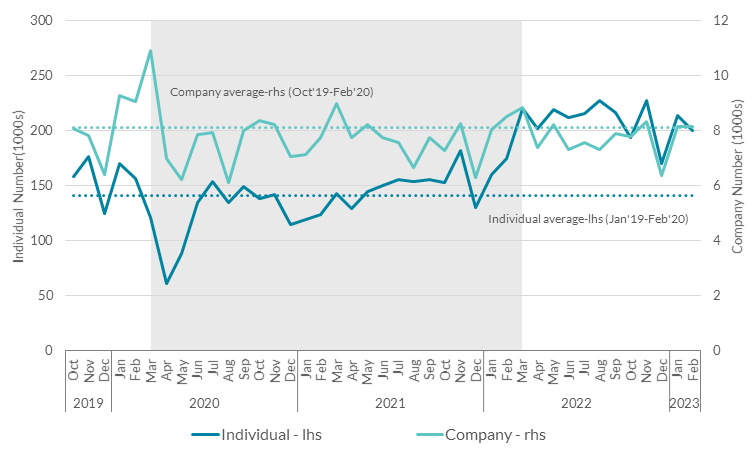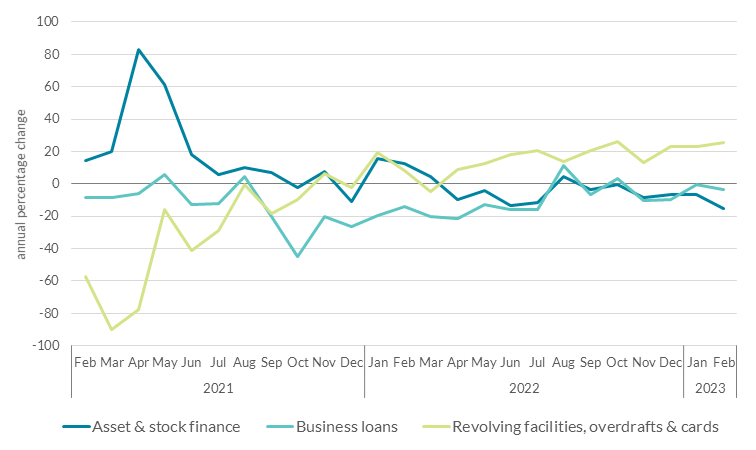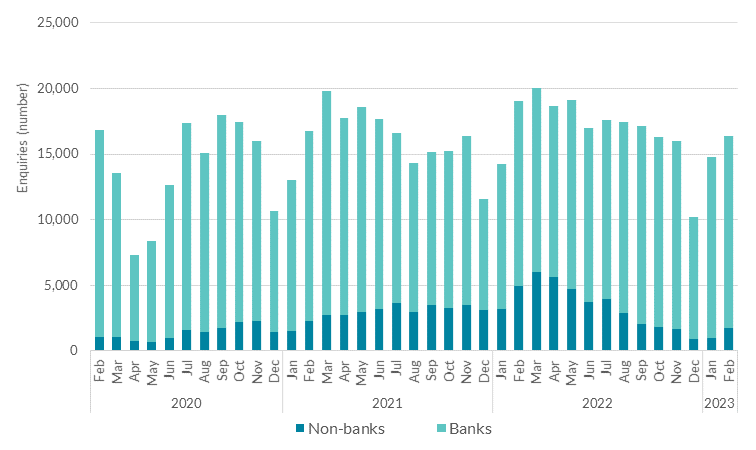Behind the Data

Credit demand and lender activity to February 2023: What can high-frequency lender credit enquiries tell us?
Martina Sherman and Maria Woods *
April 2023
Lender credit enquiries data show increased demand for short-term credit among individuals and companies over 2022 and to end-February 2023 potentially attributable to costs of living, rate increases and an evolving retail lending market. Likely reflecting their less competitive pricing, non-banks have experienced a reduction in enquiries for mortgages but remain an important source of funding for companies, particularly for asset finance.
Understanding evolving credit conditions matters for Central Bank policy discussions and future economic growth. The post-pandemic period to early-2023 with elevated macro-financial uncertainty, tighter monetary policies and mixed economic data complicates credit analyses. Survey evidence and official credit statistics while useful, contain lags requiring complementary high-frequency data. This Behind the Data (BTD), therefore, examines daily credit registry enquiry data to reveal prevailing credit preferences and related lender activity in Ireland.
As at early-2023, the direction and composition of future Irish credit demand is uncertain with rising borrowing costs, lower real household disposable incomes and a challenging operating environment for firms, despite aggregate economic resilience. Although fiscal supports and pandemic savings provide temporary respite, certain households or firms may be facing financial stress and require short-run credit. Further, a less accommodative monetary policy environment could alter credit preferences to shorter maturities at flexible rates (Lane, 2022). Equally, credit demand could reduce due to borrower caution or higher financing costs.
Future credit demand may also be affected by the evolving Irish retail lending environment. Non-bank lenders have become a feature, providing competition and new forms of finance alongside risks (see Heffernan et al., 2021, Gaffney et al., 2022 and Central Bank of Ireland Financial Stability Reviews). Additionally, the withdrawal of two main retail lenders could increase demand if borrowers need to switch lenders or decrease demand if they cannot easily access new lenders for regular borrowing needs.
Survey evidence points to differences in credit demand between firms and households amid moderately tighter credit standards in Q4 2022, with higher expected future bank credit demand among some SMEs. To complement this survey evidence and provide a more up-to-date measure of credit preferences, this BTD examines daily lender enquiries data to end-February 2023 for both individual and company new credit applications.
The data
This BTD utilises a daily report of lender credit enquiries to the Central Credit Register (CCR) from February 2020 (See McElligott et al., 2020). The granular data can be disaggregated by loan category and enquiring lender type (i.e. bank versus non-bank). Non-bank lenders refer to any entity not included on the Central Bank’s Register of Credit Institutions. Some entities classified as non-banks may belong to a banking group, and thus have different funding models to other non-banks.
While not capturing discouraged borrowers, enquiries data proxy credit demand, particularly for larger loans. The dataset has good coverage of credit applications and can be useful for future trends. Lenders must enquire for all loan applications above €2,000 and may enquire at their discretion for other applications. CCR enquiries generally precede full approvals and subsequent credit draw-downs.
Uptick in individual enquiries and short-term credit facilities
Overall, lender enquiries rose over 2022 and into 2023, led by an increase in individual credit applications in excess of the pre-pandemic average (Chart 1). Much of this growth was driven by personal loan applications (Table 1). Other consumer categories, such as mortgages and asset finance enquiries, by contrast, recorded single-digit growth over 2022 and fell in annual terms in early-2023.
The uptick in the smaller category of shorter-term credit facilities over 2022 and into early-2023 could reflect changed liquidity preferences or higher financing requirements given inflationary pressures. Individual enquiries from early-2022 may also be affected by multiple credit applications to explore options when switching lender following their bank exiting the market or given expanded offerings by certain lenders. Rising interest rates may also prompt multiple applications to secure the best terms.
Chart 1: Lender enquiries for individual applications rise over 2022

Source: Central Credit Register and authors’ calculations.
Notes: Shaded areas refers to pandemic period between first and final public health restrictions. Last observation February 2023. Pre-2020 monthly figures available for headline enquiries only.
Lender enquiries for overall company applications did not increase significantly over 2022, remaining around the pre-pandemic average with early-2023 figures suggesting annual declines. Potentially reflecting reduced investment activity or capacity building in the current uncertain environment, enquiries for the largest categories of asset/stock finance and business loans did not grow in 2022 or into early-2023.
Table 1: Sub-category analysis of lender enquiries
|
2021
|
2022 |
2022 |
2023 |
|
|
%Sharea |
%Sharea |
Annual % change |
Jan/Febb(annual % change) |
| Individual |
|
|
|
|
| Mortgages |
11 |
8 |
5.8 |
-3.9 |
| Overdrafts, revolving credit & cards |
12 |
14 |
67.4 |
25.8 |
| Personal loans
|
58 |
64 |
53.7 |
43.6 |
| Asset finance
|
15 |
11 |
3.8 |
-2.8 |
| Other non-consumer
|
4 |
3 |
-3.3 |
-0.5 |
| Total
|
100 |
100 |
40.1 |
70.3 |
| Company |
|
|
|
|
| Business leasing, hire purchase & stocking finance |
48 |
47 |
-1.3 |
-10.4 |
| Business loans |
26 |
23 |
-10.6 |
-2.3 |
| Revolving facilities, overdrafts & credit cards
|
18 |
20 |
16.2 |
27.4 |
| Other company lending
|
8 |
10 |
39.6 |
2.4 |
| Total
|
100 |
100 |
2.5 |
-1.3 |
Source: Central Credit Register and authors’ calculations.
Notes: a % share of total individual/company related enquiries.
b Sum of January and February enquiries.
Similar to individuals, preferences for short-term business credit facilities increased to early-2023 (Chart 2): a trend reflected in company bank lending data to January 2023 in Dempsey and Saupe (2023).
Chart 2: Growth in company enquiries for revolving and short-run credit over 2022 and early-2023

Source: Central Credit Register and authors’ calculations.
Notes: Last observation February 2023.
SME credit demand survey data to September 2022 confirms the broad distribution of new company applications in Table 1, with new loans, leasing or hire purchase and overdrafts being the most requested credit applications for bank finance. For non-banks, the survey shows that leasing, hire purchase and new loans were the most requested products. Among bank finance applications, the survey points to an increase in working capital related requests and a decrease in those for business expansion compared with September 2021. Moving from expansion to maintenance could suggest caution or consolidation given cost pressures.
Retail lending market shifts impact mortgage enquiry activity
The composition of lenders in the household credit market has changed in recent years, with the growing popularity of non-bank lenders. Non-bank intermediation has become increasingly important in the mortgage market, particularly for buy-to-let (BTL) lending and for refinancing (Gaffney et al. 2022). As expected, mortgage enquiries follow the same trend, with enquiries via non-bank lenders increasing from single-digit figures in early-2020 to circa 20 per cent by end-2021.
The funding model of some non-bank financing creates additional pricing sensitivity to rising rates, with volumes likely to be more pro-cyclical, (Financial Stability Review 2022:II). Preliminary evidence from developments in lender mortgage enquiries in late-2022 would appear to support this.
Table 1 shows less growth in total mortgage-related enquiries relative to other individual credit categories. Data by lender type suggests some reduction in non-bank financing in the mortgage market could be a factor. Mortgage enquiries with non-bank lenders peaked in April 2022 at just over 30 per cent of all enquiries, mainly owing to principal dwelling house (PDH) mortgages. Throughout the second half of 2022 however, many non-bank lenders announced interest rate increases, including a tightening of lending criteria, which was followed by a marked decline in mortgage enquiries by non-banks. By end-2022 and early-2023, the share of mortgage–related enquiries via non-banks has fallen to single-digits, with a marginal recovery in February (Chart 3).
For the first two months of 2023, mortgage enquiries via non-bank lenders were down 67 per cent in year-on-year terms; in contrast to bank mortgage enquiries, which increased by 13 per cent. Non-banks, however, still account for almost one-third of all BTL mortgage enquiries, and 8 per cent of PDH enquiries as of early-2023.
Chart 3: Share of non-bank enquiries for new mortgage applications reduce towards end-2022

Source: Central Credit Register, and authors’ calculations.
Notes: Data to end-February 2023.
Enquiry activity between non-bank lenders who are a member of a banking group, and those funded solely via financial markets appear to differ. Enquiries reduced quicker for those non-bank lenders not linked to a banking group over the latter half of 2022, possibility reflecting volatile market funding conditions.
Enquiries from non-bank lenders continue in company asset finance
Leasing and hire purchase finance are an important source of funding for companies. Non-bank finance companies play a leading role in this type of credit (Heffernan et al., 2021), particularly for leasing finance, with between 85 and 90 per cent of all leasing enquiries undertaken via non-bank lenders. There has been a consistent presence of non-bank lenders in this space since the daily series began in early-2020, when non-banks dealt with circa 60 per cent of all leasing and hire-purchase enquiries; this rose to over 70 per cent during 2022 (Chart 4).
Chart 4: Non-bank enquiries continue to dominate company leasing applications.

Source: Central Credit Register and authors’ calculations.
Notes: Data to end-February 2023.
In comparison, non-bank lenders have a less significant role in term loans extending to firms. However, while overall business loan enquiries have declined, enquiries by non-banks experienced a 7 per cent increase over 2022 compared to the year previous, and early-2023 data points to a similar level of enquiries compared to early-2022.
As with term loans, firms do not appear to go beyond the main retail banks for short-term credit needs such as revolving and contingent credit. Despite the announced departure of two retail banks, enquiries by non-bank lenders relating to short-term and revolving credit lines for companies has not risen, and remains relatively static at circa 1 per cent of all short-term credit enquiries.
Conclusion
This BTD examines CCR enquiries data to end-February 2023 to signal individual and firms’ credit preferences in the current uncertain environment and support further analyses. Personal loan applications drove credit enquiries over 2022. While changing market structure and expanded lender offerings likely contributed, credit preferences may also be affected by elevated living costs or tighter monetary policy, given the accompanying increase in short-term credit.
Similarly for companies, enquiries for short-term credit categories recorded consistently positive growth from early-2022, translating into NFC bank lending at shorter maturities (Saupe and Dempsey, 2023) while enquiries for larger categories of business loans and asset finance were lower than in 2021. Whether a move to a consolidating rather than an expansionary strategy by Irish firms or a signal of early financial stress for some, further monitoring is required given the implication for future investment and financial stability.
The data also reveal some compositional shifts among mortgage lenders with the share of non-bank enquiries declining relative to banks. These shifts could affect mortgage market structure and housing market developments if they persist and affect credit drawdowns.
*Email [email protected] or [email protected] if you have any comments or questions on this note. Comments from Vasileios Madouros, Robert Kelly, Jean Cassidy, Jenny Osborne-Kinch, Tiernan Heffernan and Mark Channing are gratefully acknowledged. The views expressed in this note are those of the authors and do not necessarily reflect the views of the Central Bank of Ireland or the ESCB.
See also: